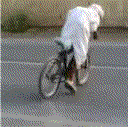So is there such a thing as a double apex turn? Sure there is, but they're rare. To be a double apex turn, it first has to be one corner, which means one turn-in point. If with that one turn-in, your line takes you to the inside, back out a bit, and back in to another apex, it's a double apex.
There are no double apex turns on the VIR South Course.

From TrackDoD Novice Group Orientation









































